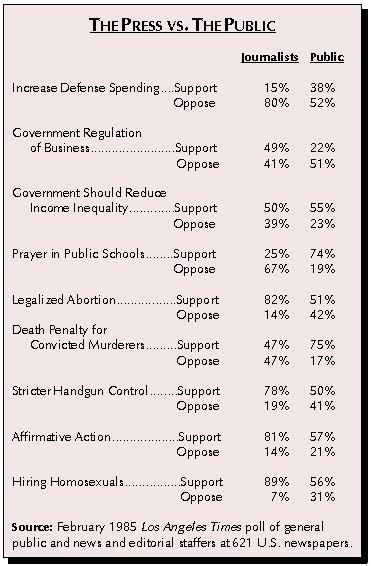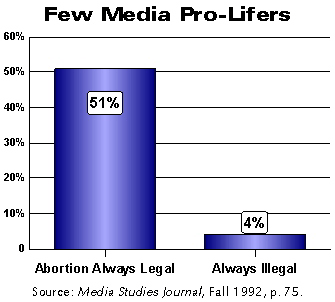 |
||||||||||||
|
||||||||||||
 |
||
|
 |
||||||||||||
|
||||||||||||
 |
||||||||||||||||||||||||||||||||||||
|
||||||||||||||||||||||||||||||||||||
|
The Liberal Media
Every Poll Shows Journalists Are More Liberal than
the American Public — And the Public Knows It
By Rich Noyes
Director of Research
June 30, 2004
Section 3 of 4
|
Issue by Issue: Always Liberal If the media elite were the pragmatic non-ideologues that Rather, Jennings and Brokaw described, one would expect to find occasional support for a few conservative policy positions, even if their overall bent was still left of center. But none of the surveys find that the national media are populated by independent thinkers mixing liberal and conservative positions. Instead, most of the journalistic elite offer reflexively liberal answers to practically every question a pollster can imagine. The most exhaustive study of journalists attitudes on specific policy issues was the poll conducted by the Los Angeles Times in 1985, which asked a series of identical questions to more than 3,000 reporters and editors and nearly 3,000 members of the general public. The pollsters found journalists to be much more liberal than their audience. “Sometimes, the readers and the journalists take diametrically opposite positions — as on the question: ‘Are you in favor of the way Ronald Reagan is handling his job as President?’ Journalists say ‘No’ by a 2-1 margin; readers say ‘Yes’ by about the same margin,” the Times’s David Shaw reported at the time. On issue after issue, a greater proportion of journalists chose the liberal option. “Sometimes, the public voted overwhelmingly on one side of a question, and the newspaper journalists were evenly divided — as on the death penalty question. On several other issues — handgun control, affirmative action, ‘withdrawing American investments from South Africa because of their apartheid policy,’ ‘allowing women to have an abortion’ and ‘hiring an employee regardless of whether he or she is a homosexual or a lesbian,’ — both the journalists and their readers say ‘Yes,’ but the Yes/No margin among journalists is always much larger than it is among readers,” Shaw explained. “When the responses to all questions on social political issues are combined, the newspaper staffs provided ‘liberal’ answers 68 percent of the time and ‘conservative’ answers 22 percent of the time. Readers provided ‘liberal’ answers 43 percent of the time and ‘conservative’ answers 37 percent of the time — which makes the public much less liberal than the newspaper journalists,” Shaw concluded.
• Pro-Welfare State, Pro-Abortion: The Times poll matched the findings of surveys conducted by Robert Lichter and his team for The Media Elite. One out of every eight reporters (13 percent) told the Lichters they supported public ownership of major corporations — a fairly remarkable percentage, although five times as many rejected such unvarnished socialism. A majority of journalists favored government activism in the economic arena to aid the poor and provide jobs. “These attitudes mirror the traditional perspective of American liberals who (unlike many European social democrats) accept an essentially capitalist economic framework, even as they endorse the welfare state,” the authors concluded. When it came to issues such as abortion, homosexuality and affirmative action, the media elite revealed solidly liberal views. Nine out of ten journalists believed a woman should have a legal right to an abortion and eight out of ten backed “strong affirmative action for blacks.” At the same time, Lichter’s research found that “75 percent disagree that homosexuality is wrong, and an even larger proportion, 85 percent, uphold the right of homosexuals to teach in public schools.” Years before Bill Clinton’s scandals made adultery a top news story, the media elite were expressing tolerance on the subject: “54 percent do not regard adultery as wrong, and only 15 percent strongly agree that extramarital affairs are wrong,” the authors disclosed. “Thus, members of the media elite emerge as strong supporters of sexual freedom, and as natural opponents of groups like the Moral Majority.”
Weaver and Wilhoit also discovered that journalists and the public differed on the importance of religion: “Our survey results show that the percentage of journalists rating religion or religious beliefs as ‘very important’ is substantially lower (38 percent) than the percentages in the overall U.S. population (61 percent). But 34 percent of journalists say religion is ‘somewhat important,’ compared to 30 percent of the population.” Those figures actually indicate a more pious press than Lichter and his team found in the early 1980s, when “exactly half” of top journalists did not identify with any religion and “only 8 percent go to church or synagogue weekly, and 86 percent seldom or never attend religious services.” • Journalists More Pro-Gay than Public: In 1995, the Times Mirror Center found a values gap when they compared the views of 228 top journalists and media executives to other groups: “The public is divided as to whether homosexuality should be accepted (41 percent) or discouraged (53 percent), as are members of Congress, top business executives and local community leaders. But members of the national media feel it should be accepted by an 83 to 4 percent margin, and this view is almost as prevalent among the local media (75 percent to 14 percent).” • Reporters Wish They Were Nicer to Clinton, Tougher on Bush: The Times Mirror poll was conducted during the middle of Bill Clinton’s first term in the White House. When it came to rating the media coverage, reporters were worried they had been too aggressive. More than a third of the journalists (35 percent) felt there had been too much coverage of the Clintons’ Whitewater scandals, versus five percent who felt there had been too few Whitewater stories. At the same time, about half of the national media (48 percent) said they felt there had been too few stories about Clinton’s “achievements,” compared with only two percent who felt the media had over-reported Clinton’s achievements. But when the Pew Research Center tested journalists in 2004, 55 percent complained that the media were “not critical enough” of President George W. Bush, compared to only eight percent who thought the press had been “too critical.” The 2004 Pew report revealed how these assessments were based on the journalists’ ideology. “Liberals who work in national and local news organizations overwhelmingly feel the press has not been critical enough of the Bush administration,” Pew reported, “but most [of the media’s] conservatives (53%) think the press has been too critical.” That same poll found that the media’s liberals outnumbered the conservatives by a five to one margin. • Elite Journalists Pro-Abortion, Pro-Gay: Rothman and Black’s 2001 update to the original Media Elite surveys found that reporters continued to profess liberal attitudes on social issues. Nearly all of the news media elites surveyed (97 percent) agreed that a woman should have the legal right to choose whether or not to have an abortion, and 75 percent agreed that “homosexuality is as acceptable as heterosexuality.” On adultery, however, the media elite had become stricter over the years, as 78 percent now agreed that it is “wrong for a married person to have sexual relations with someone other than his or her spouse.” (The earlier Media Elite survey showed a majority actually disagreed with this premise.) When it came to economic issues, Rothman and Black expressed some surprise at the continued liberalism of reporters: “Despite the discrediting of centrally planned economies produced by the collapse of the Soviet Union and other Communist regimes, attitudes about government control of the economy have not changed very much since the 1980s,” they marveled in their 2001 Public Interest article. “The cultural elite maintains strong levels of support for a more egalitarian society in which government plays a substantial role.” Indeed, the updated survey found the media’s preference for government activism had grown over the years. “When asked if the government should work to ensure that everyone has a job,” more than seven out of ten journalists (71 percent) agreed, up from 48 percent in the original surveys. Similarly, only 39 percent of reporters agreed that “less government regulation would be good for business,” whereas 63 percent had expressed that view previously. Three-fourths of journalists (75 percent) agreed that “government should work to reduce the gap between the rich and the poor,” a slight increase from the 68 percent who felt that way earlier. The conclusion that liberals dominate the national media is unassailable. Every major survey of journalists from 1970s to the present day has found that reporters are more liberal on the issues, more likely to identify themselves as liberal, and more likely to vote for a liberal presidential candidate than the rest of the country.
The Media Research Center For an interview with an MRC Spokesman, please contact Katie Wright at (703) 683-5004
Home | News Division
| Bozell Columns | CyberAlerts |
||||||||





 While some of the questions posed by the
Times in 1985 — such as soliciting opinions about South African divestment — are not especially relevant today, many tap into the same liberal-conservative divisions that characterize today’s politics. Only once, when asked whether they favored “government efforts to make reductions in the income gap between rich and poor,” was the public’s response more liberal than that of the press — although on that question news staffs still supported the liberal stance by a 50 to 39 percent margin. On every other policy issue the
Times asked about — including abortion, prayer in school, affirmative action, defense spending and the death penalty — journalists embraced the liberal position more readily than the public at large. (See chart.)
While some of the questions posed by the
Times in 1985 — such as soliciting opinions about South African divestment — are not especially relevant today, many tap into the same liberal-conservative divisions that characterize today’s politics. Only once, when asked whether they favored “government efforts to make reductions in the income gap between rich and poor,” was the public’s response more liberal than that of the press — although on that question news staffs still supported the liberal stance by a 50 to 39 percent margin. On every other policy issue the
Times asked about — including abortion, prayer in school, affirmative action, defense spending and the death penalty — journalists embraced the liberal position more readily than the public at large. (See chart.) •
Journalists Less Religious than
Public: In their 1992 study, Weaver and Wilhoit asked a broad sample of 1,156 journalists for their views on abortion, and found very few who outright opposed the procedure. “More than half (51 percent) of the journalists said abortion should be legal under any circumstance; 40 percent said it should be legal under certain circumstances, and four percent said all abortion should be illegal. The U.S. public at large appears to be much less likely than U.S. journalists to see unrestricted abortion as legal and more likely to say it should always be illegal,” they reported.
•
Journalists Less Religious than
Public: In their 1992 study, Weaver and Wilhoit asked a broad sample of 1,156 journalists for their views on abortion, and found very few who outright opposed the procedure. “More than half (51 percent) of the journalists said abortion should be legal under any circumstance; 40 percent said it should be legal under certain circumstances, and four percent said all abortion should be illegal. The U.S. public at large appears to be much less likely than U.S. journalists to see unrestricted abortion as legal and more likely to say it should always be illegal,” they reported.